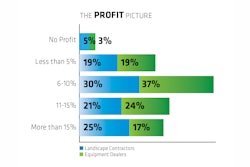In running a contracting business, few things are as important as sound estimating and budgeting. Why is it, then, that so many contractors fall short in these areas?
Let’s be honest: Some aren’t disciplined enough to stay on it. Others simply don’t want to take the time to do it at all. But for many, estimating and budgeting is a very intimidating, confusing part of the business.
The fact is, budgeting and estimating can be as complex—and confusing—as you want to make it. But at the end of the day, you need to know how much you’re selling, how much you’re spending, what to expect in the future, and how you can make improvements.
Charting Your Course
The first step is simply making sure your chart of accounts is established and well-understood. The chart of accounts, which should follow those listed on your income statement, provide a listing of names and accounts your company has identified for recording transactions. “Remember, a company has the flexibility to tailor its chart of accounts to best suit its needs, which includes adding accounts as needed,” says Jon Ewing, a former contractor and now business consultant.
Generally speaking, smaller companies want to list their assets, liabilities, equity, revenue and expenses. You may want to get a little more detailed. For instance:
Revenue
- Residential construction
- Commercial construction
- Residential maintenance and lawn care
- Commercial maintenance and lawn care
- Snow removal
- Tree care
Direct Costs
- Labor
- Materials
- Workers’ comp
- Payroll taxes
Indirect Costs and Overhead
- Vehicles and equipment
- Marketing
- Insurance
- Rent
- Utilities
- Administrative … etc.
“It’s important that you have some sense of historical data for each line item you identify,” Ewing explains. Take a look at the past few years to see how revenue and cost from each line item has been trending. “If the data isn’t available, you need to assign an estimated value to each line item,” Ewing says. “But of course, actual historical data is going to be better than just going with your gut.”
Forecasting Revenue
Once your chart of accounts has been established and dollar values have been assigned to each line item, you should start trying to forecast revenues. Here’s where a little more detail will really come in handy.
“I recommend further breaking your revenue down by specific jobsite classifications, such as HOAs, municipalities and retail facilities,” Ewing says. For example:
Commercial Maintenance:
- Sports facilities
- Manufacturing facilities
- Retail facilities
- Municipalities
“From there you can analyze the opportunities each specific group presents,” Ewing goes on to explain. “For example, you may look at municipalities and forecast that you have a 10% increase in sales opportunities. Or on the residential side, the HOAs you service haven’t been impacted as much by the recession, so you could realistically grow sales 5% there.”
Forecasting Expenses
Once you’ve done some thinking and put a realistic sales forecast together, it’s time to estimate your expenses. Direct costs (labor and materials) will rise and fall in correlation with revenue projections, so this shouldn’t be too difficult. However, as you’re growing sales, it’s important to recognize the fact that, due to potential economies of scale, you could have a great shot at reducing your direct costs and improving your gross margin.
With respect to indirect costs and overhead, they are normally fixed, meaning that they do not rise or fall with changes in revenue—unless you add sales or admin staff, buy new equipment, make facility improvements, increase marketing, buy new software, etc.
Conversely, Ewing says many businesses have opportunities to eliminate some fixed costs, perhaps by seeking rent reductions or lease improvements, or selling idle equipment. “Any savings you realize would then be reflected in your budget, improving your profit forecast—which is the name of the game,” Ewing points out.
Making It Happen
Once the budget is in place, you have established your targets based on intelligent assumptions. In order to then go out and make it happen, you must model your business plan to strive to attain all targets and goals set forth in your budget.
For example, if your sales goal target for municipalities calls for a 10% increase, identify that number and track it through consistent tracking methods. Perhaps you would meet with your sales team bi-monthly to evaluate your progress and investigate all opportunities required to achieve your goal. From the cost end, it is also imperative that you monitor costs each month to make sure you are tracking as planned.
Through this disciplined approach, you are able to better manage and eliminate surprises. And hey, those surprises are the one thing contractors hate even more than wrestling with numbers. So here’s to becoming a numbers guy.





















